Understanding CIRS
Chronic Inflammatory Response Syndrome
With significant chronic disease and autoimmune illnesses continually on the rise, many are exploring alternative, holistic approaches to taking back their health.


With significant chronic disease and autoimmune illnesses continually on the rise, many are exploring alternative, holistic approaches to taking back their health.
Considerable strides in scientific data and anecdotal accounts outside of Western medicine and the mainstream narrative have enabled self-empowerment when comes to nutrition, diet, and lifestyle. And while these essential pillars of health are often the root cause of most chronic conditions, what if you’re still experiencing symptoms and unable to completely heal? This missing piece to countless medical mysteries and misdiagnosed illnesses was fortunately discovered by Dr. Ritchie Shoemaker in 1997 and is referred to as Chronic Inflammatory Response Syndrome (CIRS).
CIRS, also known as biotoxin illness, has revolutionized our understanding of autoimmunity and mold consequences as well as given many chronic illness patients the opportunity for root cause healing. Backed by decades of research, considerable peer-reviewed data, and a clinically proven treatment protocol, CIRS awareness is more critical than you can imagine with approximately 25% of the population genetically susceptible. Let’s take a deeper look into what CIRS is, the treatment protocol, and other important supports for this condition.
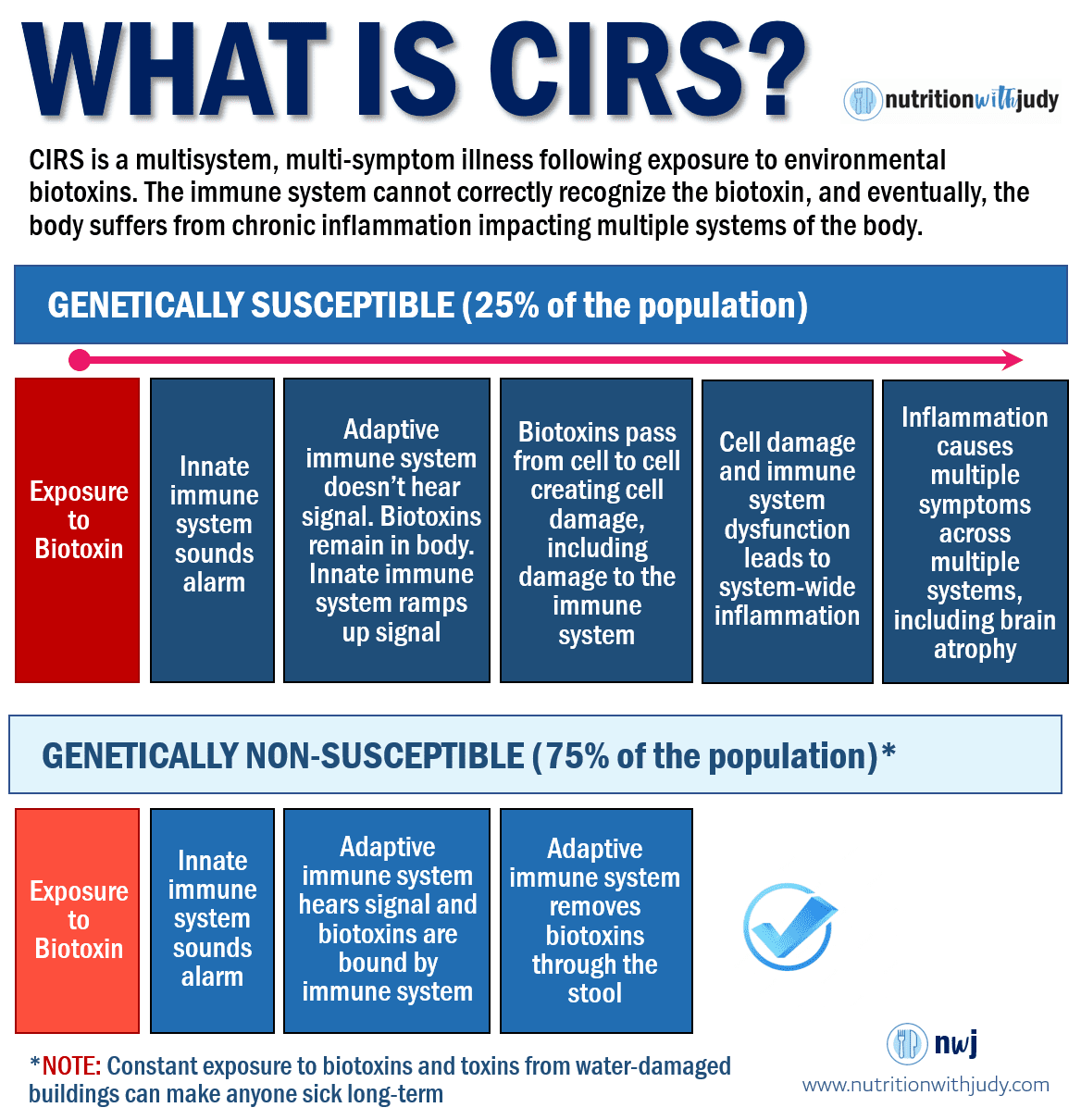

CIRS is a complex multi-system, multi-symptom disease caused by whole-body inflammation due to an overactive immune response. CIRS is a legitimate medical diagnosis that requires specific lab testing and patient history analysis in order to verify. Since CIRS symptoms can vary so differently from patient to patient, many are misdiagnosed or left untreated. Unlike other immunity disorders that can be characterized by an inappropriate adaptive immune response, CIRS can’t be identified by traditional autoimmune blood markers.
So, what causes this overactive immune response and general whole-body inflammation? Biotoxins. Biotoxins refer to substances that are toxic and biological in origin. The sources of biotoxins that can trigger and exacerbate CIRS include:
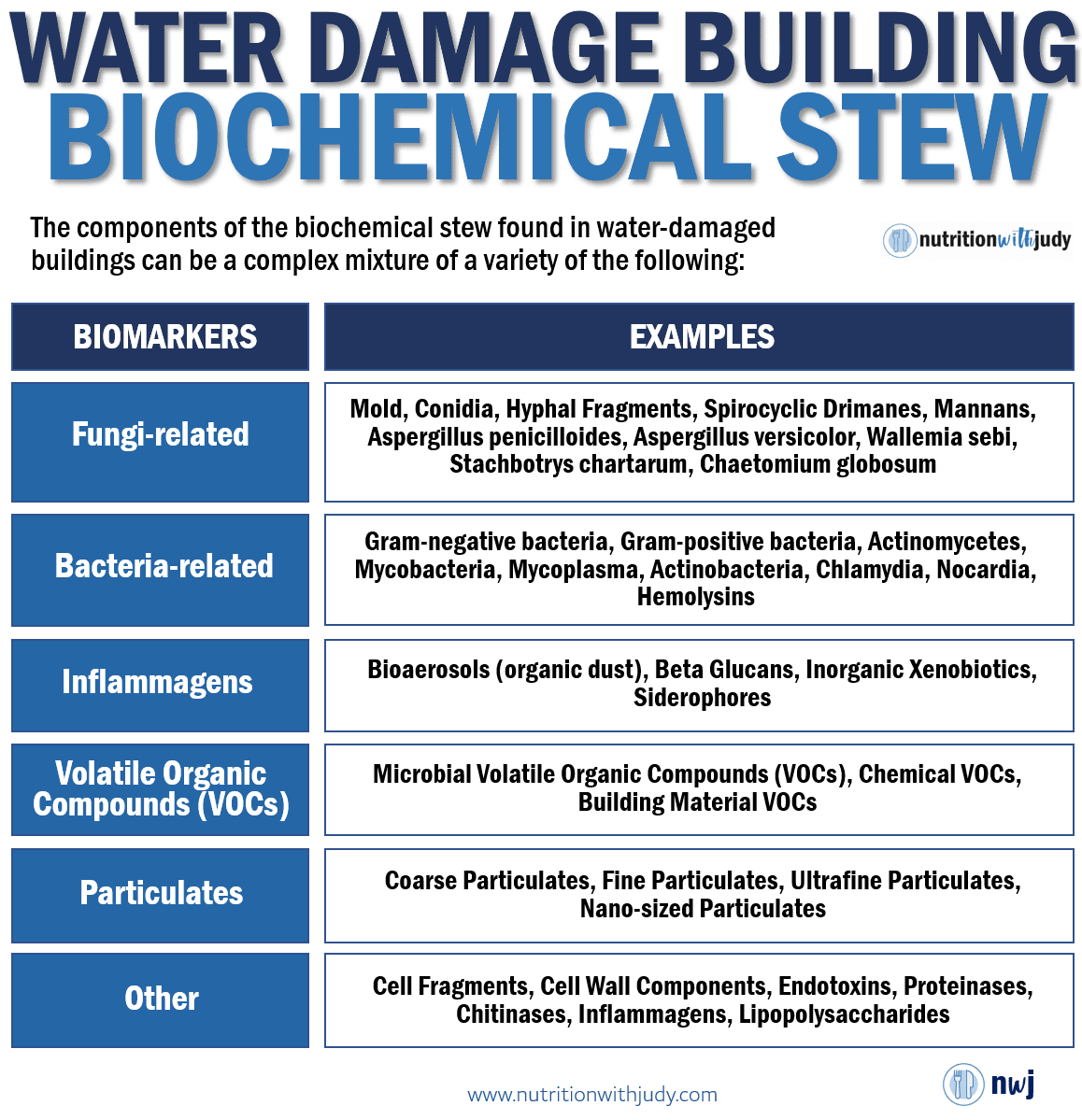

Since these biotoxins have extremely small molecules that are capable of transporting from cell to cell through the cell membrane, they can be almost impossible to detect in standard blood work. As outlined above, these biotoxins are generally introduced through inhalation but can also be ingested, contracted through tick and spider bites, and/or direct contact with contaminated water.
While some of these biotoxins are rarer, how come the encounter of some of the more common biotoxins such as mold doesn’t cause CIRS in everyone? That’s because both genetic susceptibly and the experience of a traumatic event play a key role in developing biotoxin illness. Severe stress, illness, surgery, high fever, pregnancy, significant biotoxin exposure, and other traumatic events may trigger a cytokine storm, in turn, activating the CIRS gene in those that are genetically susceptible from birth (born with HLA-DR genes). This means that CIRS can develop at any age– a lack of symptoms does not mean you’re immune and genetic haplotype testing can offer preventative insight.
Biotoxins can cause an acute illness but for most people, the immune system is able to identify these biotoxins and detox them correctly. In CIRS, the genetically-susceptible individuals have immune systems that aren’t capable of recognizing these biotoxins and therefore aren’t able to remove them on their own. This leads to the accumulation of biotoxins circulating in the body indefinitely, which causes an overactive immune response and general inflammation, leading to all the downstream symptoms and impacts.
Before we delve into the diagnosis criteria and treatment protocol for CIRS, let’s take a look at how this condition impacts the immune system and the downstream consequences.
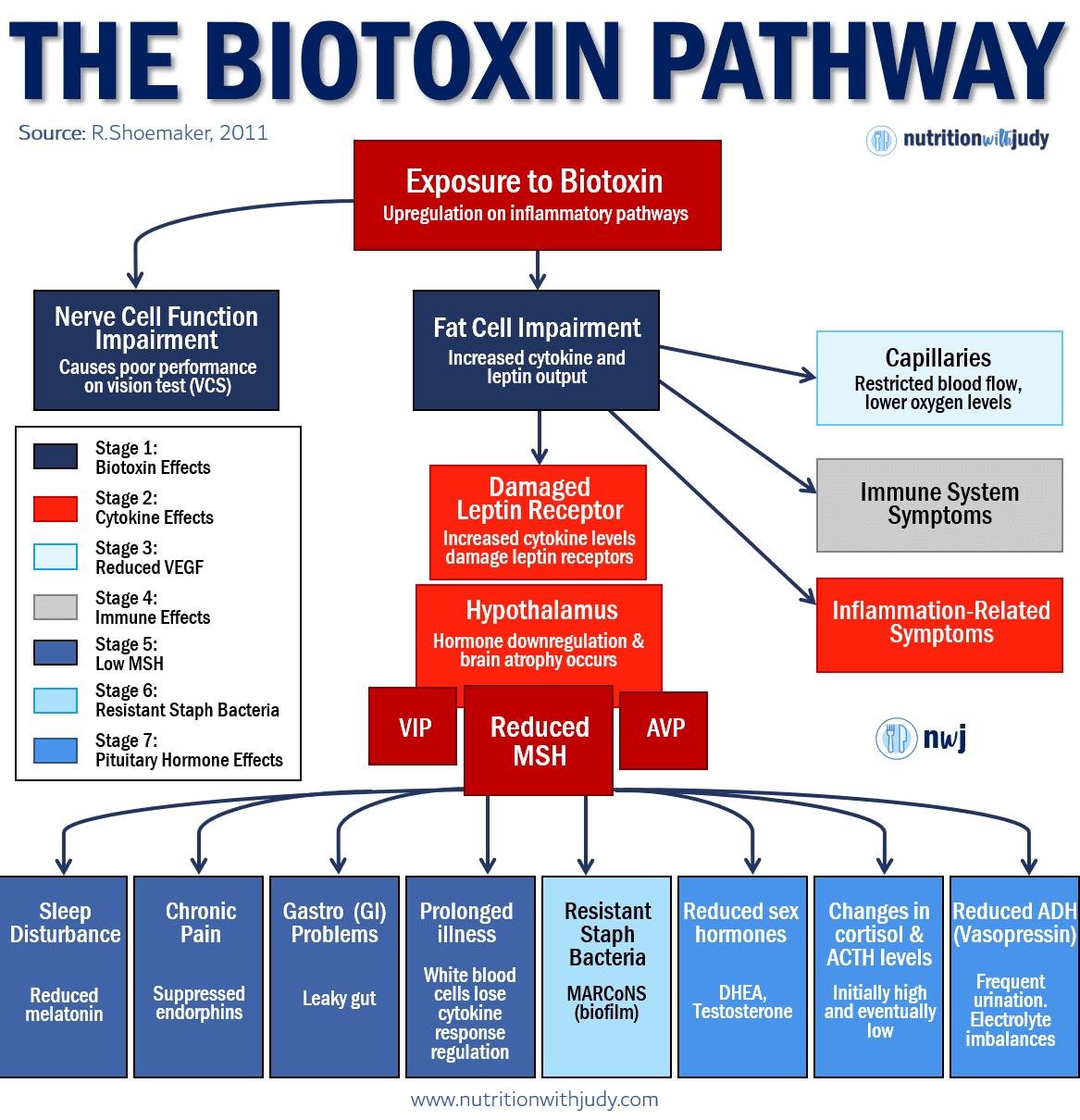

The biotoxin pathway explains the downstream effects of CIRS and the implications on the compromised immune system:
It all begins when a genetically-susceptible individual is exposed to a biotoxin. For most people, the biotoxin is identified and tagged by the immune system, broken down, and detoxed from the body via the liver. For individuals that don’t have the appropriate immune response genes, known as HLA-DR genes, their immune system never forms the antibodies needed for the foreign antigen. This leads to biotoxins circulating in the body indefinitely, wreaking havoc across all systems.
Once the biotoxins are introduced to these genetically-susceptible individuals, their presence causes a complex downstream effect of biochemical events. These biotoxins bind to the surface receptors of almost every kind of cell in the body. This binding act leads to continual upregulation of various inflammatory pathways including increased cytokine production. Biotoxins will also impact nerve function directly in addition to causing whole-body, chronic inflammation.
Cytokines are proteins that act as key modulators for inflammation in the body. In a healthy immune system, cytokines are produced in response to invading pathogens and are involved in the up-regulation of inflammatory responses.
With CIRS, since the immune system is unable to identify the biotoxins for proper removal and antibody creation, the cytokines bind to their receptors instead. This causes the release of Matrix Metalloproteinase-9 (MMP9) in the blood. The MMP9 then transports inflammatory elements from the blood to sensitive tissue which can increase poor circulation and clot formation.
In terms of the brain, cytokines bind to leptin receptors which prevents normal functioning while reducing the production of melanocyte-stimulating hormone (MSH). Leptin receptors are responsible for metabolism regulation and are also important for immunity and reproductive function. These initial symptoms caused by elevated cytokines often include difficulty concentrating, inconsistent body temperatures, headaches, and muscle aches.
The most significant takeaway from cytokine effects is MSH deficiency, which we’ll further detail in stage five.
Elevated cytokine levels in the blood attract white blood cells which further restricts blood flow, lowers oxygen levels in bodily tissue, and reduces vascular endothelial growth factor (VEGF). VEGF is a signaling protein that promotes the growth of new blood vessels. It also plays an important role in restoring the blood supply to cells and tissue when deprived of oxygen. Lowered VEGF levels lead to symptoms such as muscle cramps, fatigue, shortness of breath, and reduced exercise ability.
At stage four, individuals with specific immunity-related HLA gene types may develop further inappropriate immune reactions. These reactions can include autoimmune issues, gluten sensitivity, and blood clotting abnormalities. We’ve seen a variety of patients that have developed issues such as multiple sclerosis (MS), ulcerative colitis, and other autoimmune conditions due to CIRS.
In all CIRS cases, the complement system becomes chronically activated. The complement system, also known as the complement cascade, is part of the immune system that’s responsible for enhancing the ability of antibodies in order to clear damaged cells, remove microbes, promote inflammation, and attack pathogens. With a chronically activated complement system, this presents as “out of control” inflammation which impacts every system of the body including the brain. It also results in high levels of C4a which is an anaphylatoxin that activates inflammatory immune cells.
The combined results of elevated cytokines, increased MMP9 in the blood, reduced VEGF, and lowered MSH can lead to “leaky junctions” in the blood-brain barrier and the gut. “Leaky brain” allows for neuropathic toxins to enter the brain, leading to significant brain inflammation along with the dysregulation of the pituitary and hypothalamus.
MSH is a critical hormone that’s responsible for regulating other hormones, immune function, and inflammation. Over 95% of CIRS patients have low MSH. The cascading symptoms of low MSH along with the presence of specific immunity-related HLA genes (discussed in stage four), helps explain why symptoms can vary so much from each individual with CIRS.
With reduced MSH, the production of melanin is decreased resulting in chronic fatigue and poor, non-restorative sleep. The suppression of endorphins also occurs, causing chronic pain. The “leaky junctions” contributed by the lack of MSH in turn creates leaky gut. Leaky gut, which has been linked to autoimmune disease, advances the weakened and deregulated state of the immune system. White blood cells ultimately lose the normal cytokine response, allowing for opportunistic infections to occur and subsequently slower recovery times.
Another downstream effect of low MSH is the opportunity for antibiotic-resistant staph bacteria, also known as MARCoNS, to survive in the biofilm of the nasal cavity. MARCoNS are prevalent in over 80% of MSH-deficient CIRS patients due to the “leaky junctions”. MARCoNS produce toxins that further destroy MSH levels further exacerbating the symptoms experienced.
The last downstream effect of low MSH can be reduced pituitary production of antidiuretic hormone (ADH). Up to 80% of CIRS patients have dysregulated ADH/osmolality levels. Symptoms of this present as frequent urination, thirst, low blood volume, low blood pressure, and static electricity shocks.
Sex hormone production is generally down-regulated while the pituitary may upregulate production of adrenocorticotropic hormone (ACTH) and cortisol. As the illness progresses, the pituitary can then drop to severely low or low-normal ranges.
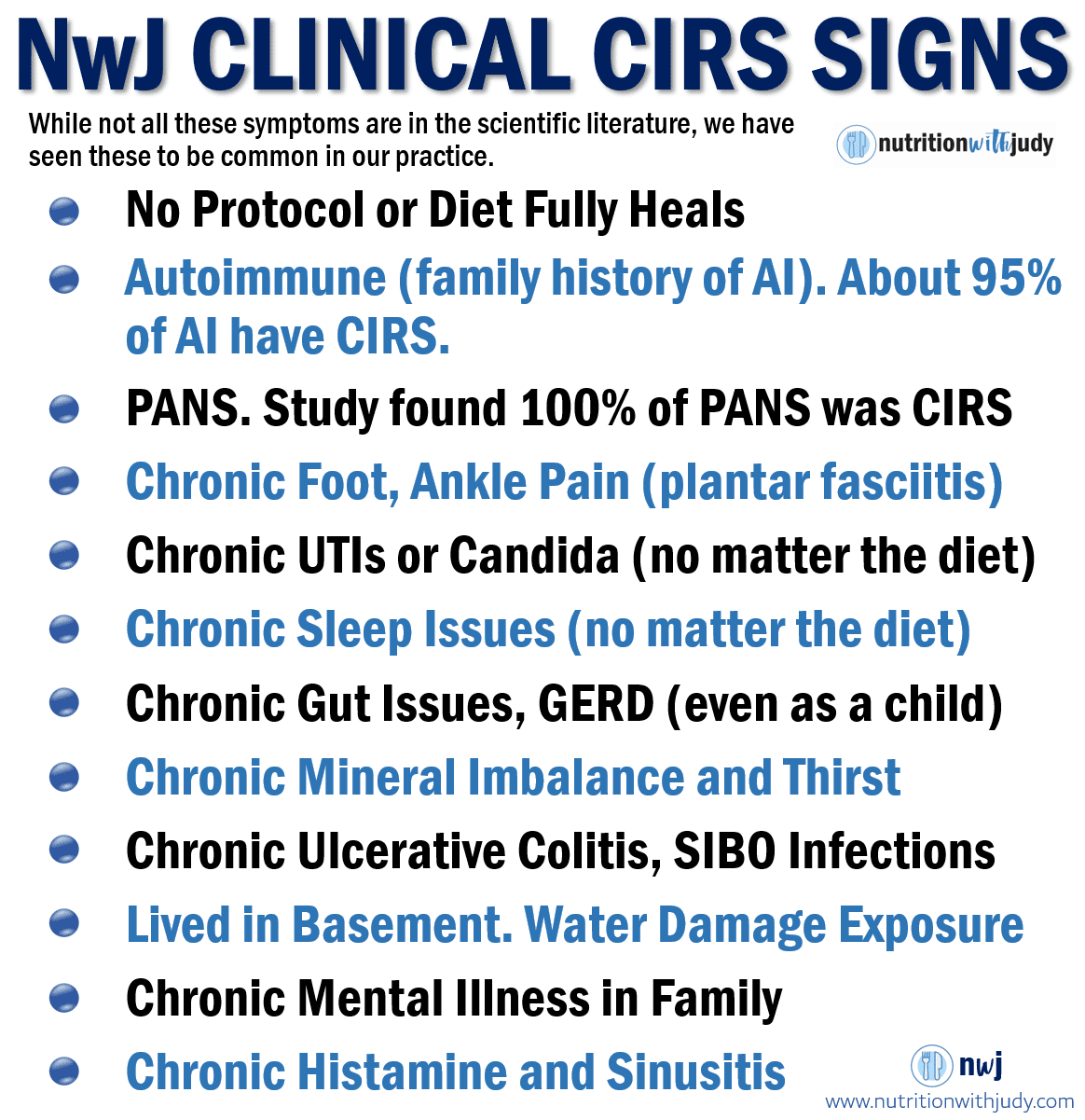

Due to the biotoxin pathway, CIRS can impact every bodily system creating a vast laundry list of symptoms that present differently from patient to patient. Here are some of the more common CIRS symptoms:
Since many of these symptoms are related to other conditions, this is another reason why CIRS is often misdiagnosed. The diagnostic criteria for CIRS involve multiple steps including having a certain number of symptoms. If you’re experiencing several of these symptoms, the next step is evaluating the rest of the criteria for a confirmed diagnosis.
In addition to the complexity of this condition, there’s a widespread lack of awareness in the Western medical community and holistic wellness spaces. CIRS symptoms are commonly confused with other illnesses. Here are some of the common misdiagnoses:
Due to the vast complexities of CIRS and how biotoxins impact different bodily systems, there are multiple diagnostic criteria an individual must meet in order to have a confirmed diagnosis. According to the Environmental Protection Agency, about 50% of homes and 85% of commercial buildings have water damage. With approximately 25% of people being genetically susceptible to CIRS, up to 40 million Americans are likely living with this condition.
If you’ve been going down the rabbit hole looking for root cause healing for some time and are still unwell, unable to lose weight, or require extensive biohacking to feel better, you may want to look into the preliminary diagnostic criteria to see if blood work confirmation is needed.
The first three steps of CIRS diagnosis can be completed without a provider and are the best place to start.
Since water-damage molds are responsible for about 80% of CIRS cases, it’s important to evaluate your past history when it comes to homes you’ve lived in, places you’ve worked at or gone to school, and any other buildings you’ve frequently visited. Since memory problems are a common symptom of CIRS, it can take some to remember if you’ve ever experienced anything ranging from a small leak under your sink to seeing water damage on the commercial tiling of your workplace.
Other biotoxin exposures to consider are tick and recluse spider bites, eating seafood that resulted in severe food poisoning, direct contact with stagnant water in areas that can develop algae, sewage exposure, and a history of certain vaccinations. Writing down any potential exposure events you can remember is the first step.
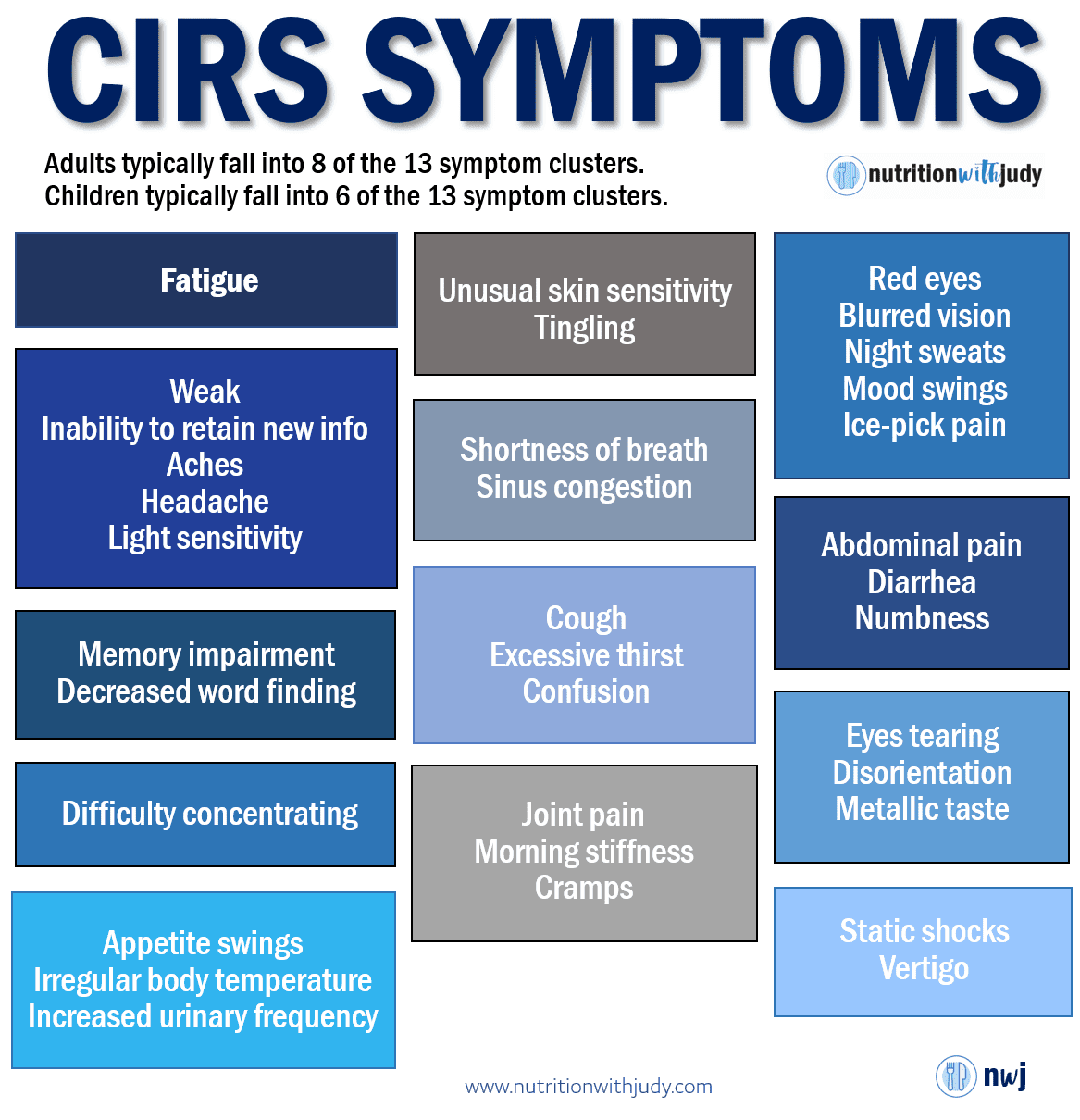

As mentioned above, CIRS symptoms often overlap with other conditions. Having some of the symptoms doesn’t necessarily mean you have CIRS. For the diagnostic criteria, the symptoms have been grouped into 13 different clusters based on the implications of the biotoxin pathway. Individuals that have symptoms in at least eight of the 13 clusters and a history of exposure should consider completing the next step. While there are multiple symptoms in each cluster, you only need one for that cluster to be considered positive.
Tip: The VCS test in the next step offers symptom cluster testing online if it’s more convenient to take a quiz. Otherwise, highlight or circle which symptoms you have from the graphic and see if you have a total of eight clusters or more. Remember, you only need ONE symptom in that cluster for that entire cluster to be positive.
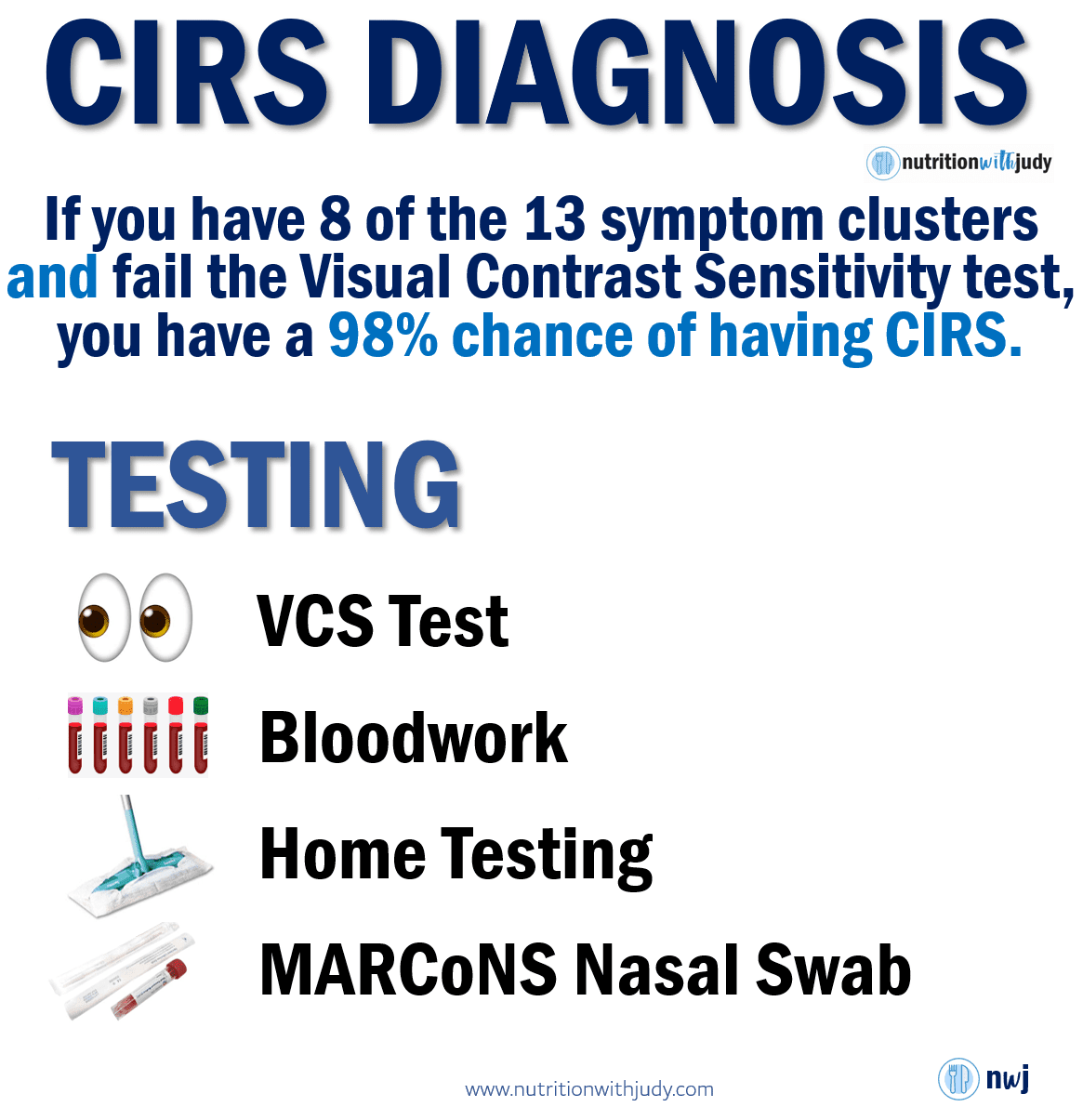

If you’ve determined that you have eight or more positive symptom clusters and have a history of exposure, the next step is taking the VCS test. First-time users can take the test for free here or use the official VCS test from Dr. Shoemaker for a nominal fee here. In the 1960s, the air force created the visual contrast sensitivity test as an objective biomarker of pilot health, which is still used today. The purpose of the VCS test is to see if you have the ability to distinguish between low contrast levels in order to determine neurological function. It involves a series of images of decreasing contrasts and the results can aid in the diagnosis of visual system dysfunction which is a symptom of CIRS.
Referring back to stage three of the biotoxin pathway, the white blood cells created by the innate immune system’s response to biotoxins restrict blood flow in the capillaries. Therefore, the capillaries in the optic nerve are impacted by decreased blood flow due to the lowered VEGF, causing CIRS patients to lose contrast sensitivity.
While the VCS test isn’t foolproof and about 7% of CIRS patients will have a false pass, individuals with eight out of the 13 symptom clusters who fail the VCS test have a 98% chance of having CIRS.
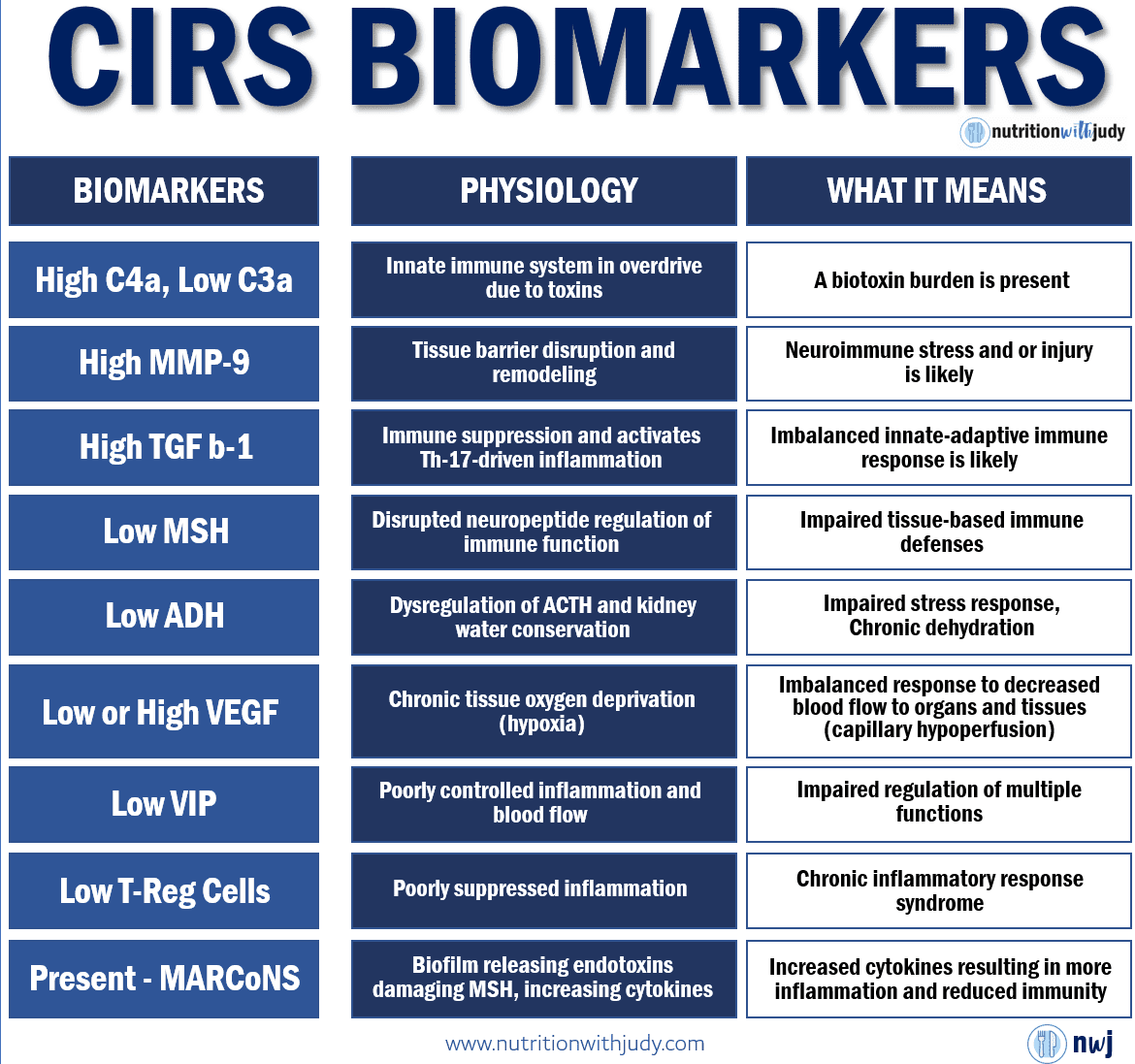

After you’ve completed the first three steps and have determined that you have a history of exposure, at least eight of the 13 symptom clusters, and have failed the VCS test, the next step is working with a provider to run blood work. Even if you haven’t failed the VCS test but have the first two criteria, you may want to consider blood work in case you happen to be part of the 7% that experience a false pass.
The first lab test needed is the HLA-DR which identifies the genetic susceptibility to CIRS. Please note, it is extremely rare to have CIRS if you do not have the haplotype. However, about 5% of CIRS cases are not in genetically-susceptible individuals. Working with a professional CIRS provider is best to help navigate this scenario in order to get proper treatment.
In addition to the HLA-DR genetic testing, blood work for specific markers will be needed. We offer in-house lab work for CIRS Testing which can be taken at any LabCorp location. These specific labs will be used for both diagnosis and monitoring clinical progress for CIRS:
MSH (normal range: 35-81 pg/mL): Also known as the “master gland”, MSH regulates a number of hormone and anti-inflammatory functions. More than 95% of CIRS patients have low MSH due to the impact of the biotoxin pathway and experience an increased vulnerability to mold toxins, sleep issues, gut concerns, mood swings, hormone abnormalities, and more.
TGF Beta-1 (normal range: <2380 pg/mL): This significant marker plays a key role in regulating the innate immune system. The multifunctional protein regulates immune function, cell survival, and cell migration. Elevated TGF Beta-1 can cause a number of autoimmune, neurologic, and other systemic problems.
C4a (normal range: 0-2830 ng/mL): C4a, part of the complementary system outlined above, is an inflammatory marker that’s critical for CIRS diagnosis and monitoring. C4a displays the innate immune response in individuals with exposure to water-damaged buildings. This marker is elevated within 12 hours of acute exposure. C4a will drop quickly once out of exposure during the treatment protocol.
MMP-9 (normal range: 85-332 ng/mL): This enzyme is involved in breaking down disease and certain tissues in normal physiology. With increased MMP-9 levels, tissue disruption within blood vessel walls leads to inflammation of the brain, lungs, muscles, joints, and peripheral nerves.
VEGF (normal range: 31-86 pg/mL): VEGF stimulates new blood vessel growth, increases blood flow, boosts circulation, and supports oxygen and nutrition delivery throughout the body. Reduced VEGF leads to inadequate blood flow and cell starvation which are serious, yet common implications of CIRS.
VIP (normal range: 23-63 pg/mL): Vasoactive intestinal polypeptide (VIP) is a neuropeptide that’s responsible for regulating the cytokine response, pulmonary artery pressures, and whole-body inflammation. Low VIP levels are typical for CIRS patients and can lead to shortness of breath, especially during exercise. Low VIP can also contribute to diarrhea. This neuropeptide plays a similar role to MSH in regulating inflammatory responses.
Additional markers may be tested by providers in order to get a better understanding of all the downstream impacts caused from the chronic, whole-body inflammation. However, these are the necessary markers needed for diagnosis. For those with financial constraints, we also offer a Mini CIRS Panel with limited markers and genetic susceptibility testing that provides a confirmed diagnosis but other markers will likely need to be tested during treatment for CIRS monitoring.
Once you’ve completed your lab work and confirmed that you have dysregulated CIRS markers and/or one or more of the genetic haplotypes, the last step is finding a Shoemaker-certified CIRS practitioner. Once the patient completes the foundational steps of the protocol, the CIRS provider will prescribe a binder medication with a specific charge and receptor site size that allows it to find and remove biotoxins from the body. Working with a certified CIRS provider is critical to accomplish root cause healing since this prescription-only binder is required for treating CIRS.
Traditional mold and other detox protocols that utilize charcoal and clay may help CIRS patients feel better but this only offers symptom management and will not cure them. After taking the appropriate CIRS binder, patients should experience noticeable alleviation from symptoms and pass the VCS vision test, which usually occurs after four weeks of treatment.
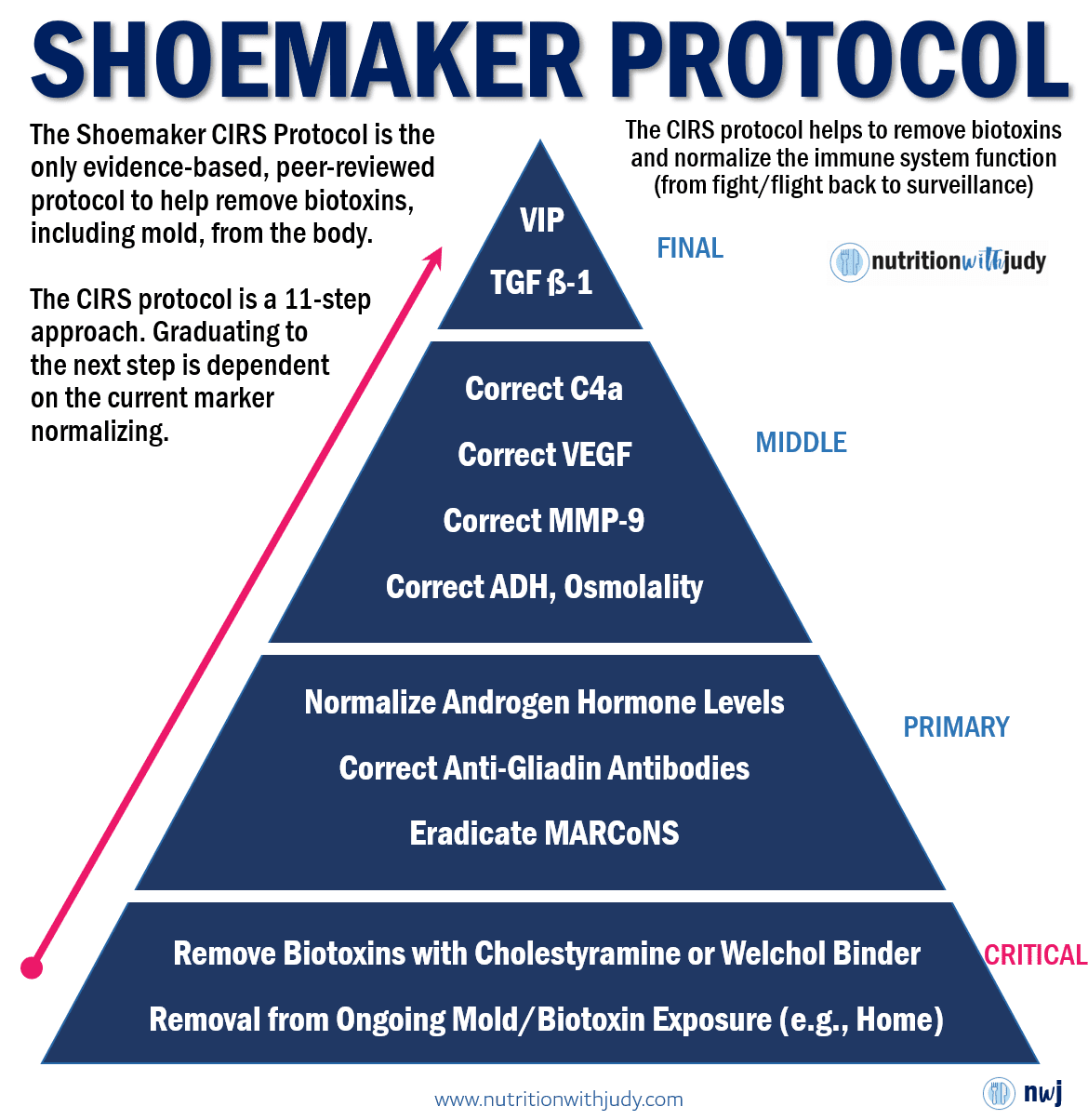

There’s a lot of noise and misconceptions when it comes to mold in both Western medicine and functional medicine worlds. The Shoemaker protocol is the only peer-reviewed, clinically-proven treatment for CIRS and has helped tens of thousands of patients with root cause healing. Created by Dr. Shoemaker, the pioneer of biotoxin illness, the Shoemaker protocol is a multi-step treatment protocol that addresses all the downstream effects of the biotoxin pathway.
There are four phases in the CIRS treatment protocol:
It’s critical that each phase must be completed before moving on to the next.
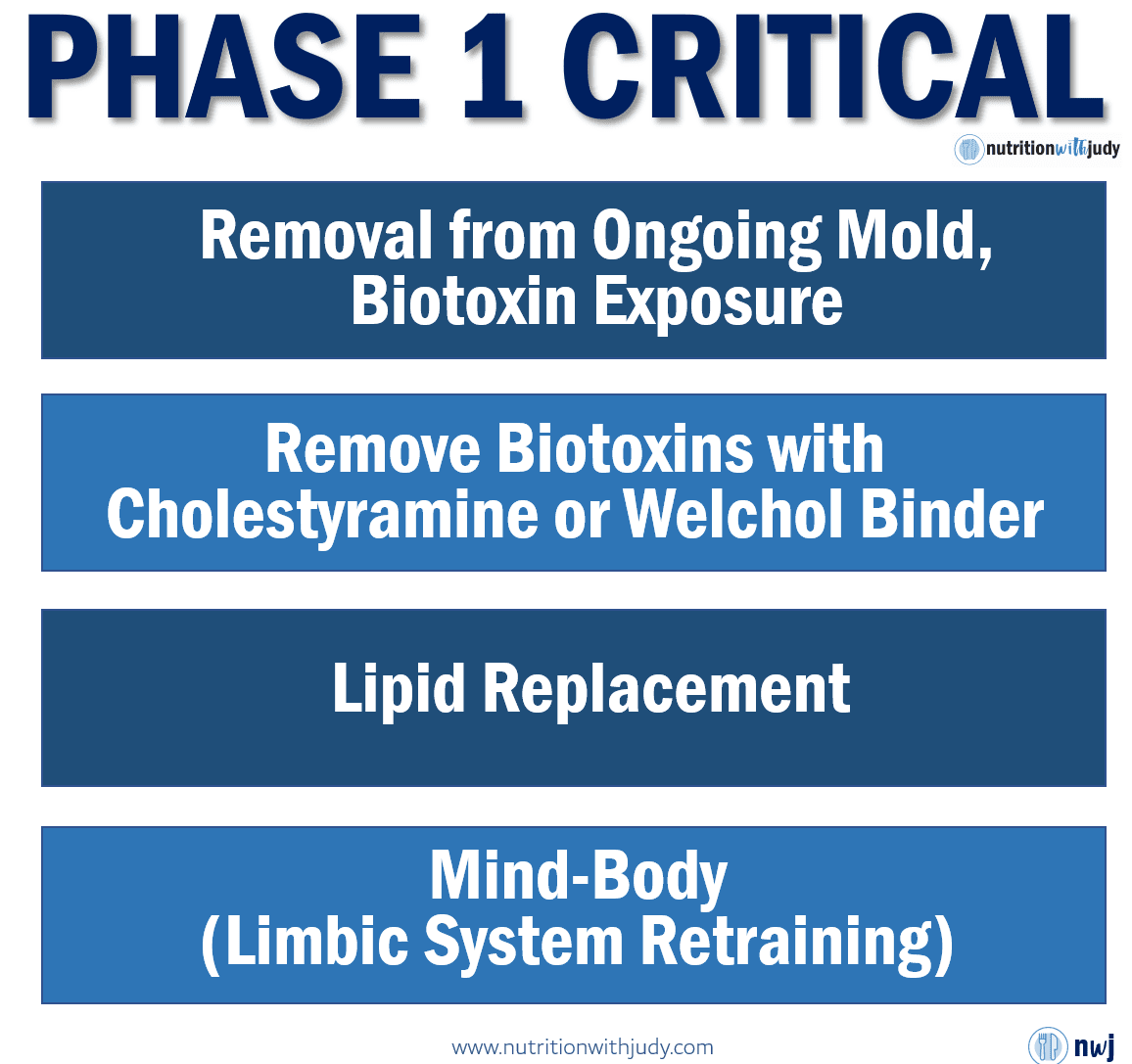

This phase of the CIRS treatment protocol implements lipid replacement therapy, limbic retraining, biotoxin removal, and the removal of mold/biotoxin exposure. While lipid replacement and limbic retraining aren’t specifically mentioned in the Shoemaker Protocol, they are important supports to ensure the better toleration of all steps.
Removal from ongoing mold and/or biotoxin exposure is often the most difficult part of the entire protocol. From home remediation to Lyme disease treatment, getting out of exposure and/or eliminating inbound biotoxins is required. You’ll need a safe home and/or workplace with safe numbers of biotoxins (it’s impossible to have a completely mold-free home) to heal and ensure efficacy throughout the protocol. This step can take place before, during, or after starting lipid replacement and limbic retraining. Using appropriate environmental testing, specifically the ERMI/HERTSMI-2 testing is required to determine the current level of specific mycotoxins and biotoxins. CIRS providers will have the resources to help with this complicated step.
Toxin levels are corrected with a binder prescribed by a CIRS provider. Cholestyramine (CSM) and Welchol are the most effective binders needed for CIRS treatment. Welchol is a quarter as effective as CSM but is ideal for sensitive individuals and those that can’t tolerate CSM. Some individuals aren’t able to tolerate either at first and will be provided with other alternative binders to begin. These drugs bind to biotoxins for elimination.
Tip: With CIRS, the biotoxins that recirculate the body are stored in the gallbladder and excreted along with bile. To help the CSM or Welchol with detoxing, it’s best to take some of your doses after a meal and to make sure you’re eating high-fat content.
Since the binder required in CIRS treatment has the potential to strip cells of their fatty cell walls, lipid replacement therapy is also important for tolerating the protocol. Establishing a healthy omega 3:6 ratio is achieved through supplementing with high doses of fish oils. For those with severe histamine intolerance that don’t tolerate fish oils, eating wild-caught king salmon daily and grass-finished beef can help raise omega-3 levels through diet intervention.
Mind-body work, including limbic retraining, is a critical, often overlooked tool in the Shoemaker protocol. The limbic system is part of the autonomic nervous system and is affected by CIRS. We have not seen people heal only with mind-body work. Inflammatory markers such as TGF-Beta 1, C4a, and MMP-9 will not reduce with mind-body work alone. It is often a fine balance of both (and at the appropriate times) that makes optimal healing possible. If doing limbic work is too strenuous at first, you can consider modalities that are less active. Mind-body supports such as the Safe and Sound Protocol can be a passive support to start balancing the nervous system. Breathing and tactile exercise, emotional freedom technique (EFT, Tapping), and being in nature can also help begin the progress.
Since our brains create neural pathways in response to our experiences, they can sometimes develop inappropriate pathways by mistake. For instance, have you ever gotten the stomach flu after eating a specific food and then after that experience, gotten nauseous from smelling that same food? Even if the food didn’t cause the illness, your body now associates the smell of it with becoming sick.
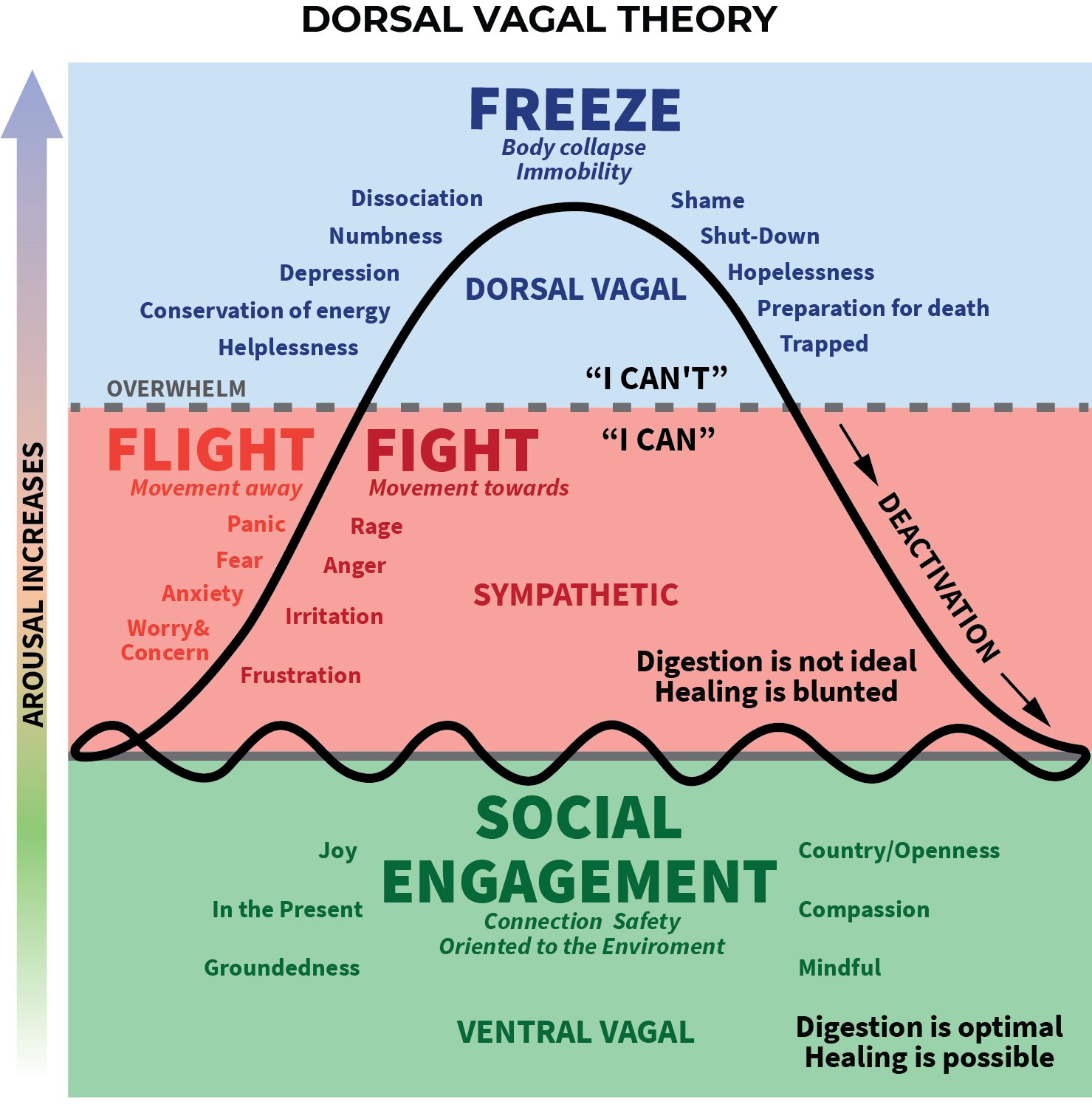

Chronic illness patients experience this at a much higher rate, unintentionally creating inappropriate neural pathways. You may start to experience histamine reactions to certain foods, scents, or chemicals that never triggered you before. Especially with CIRS, since the immune system is unable to identify biotoxins in the body and the mind is trying to find what is causing these cytokine storms and inflammatory responses, limbic dysregulation is very common.


We believe healing encompasses both the mind and body, which is why limbic work is a critical step. Limbic retraining is the process of rewiring these neural pathways so that the body stops reacting to conditioned triggers. In our clinical practice, we’ve had patients that experience significant symptom relief from mind-body work alone before they’re even able to start the CIRS treatment protocol. With a dysregulated nervous system, many physiological systems can be impacted by the “flight or fight” response. It’s important to help guide the body back to its natural “rest and digest” state. For mind-body limbic retraining work, the Nutrition with Judy team can provide one-on-one and group program support. Our nutritional therapists have been trained in DNRS and somatic training.
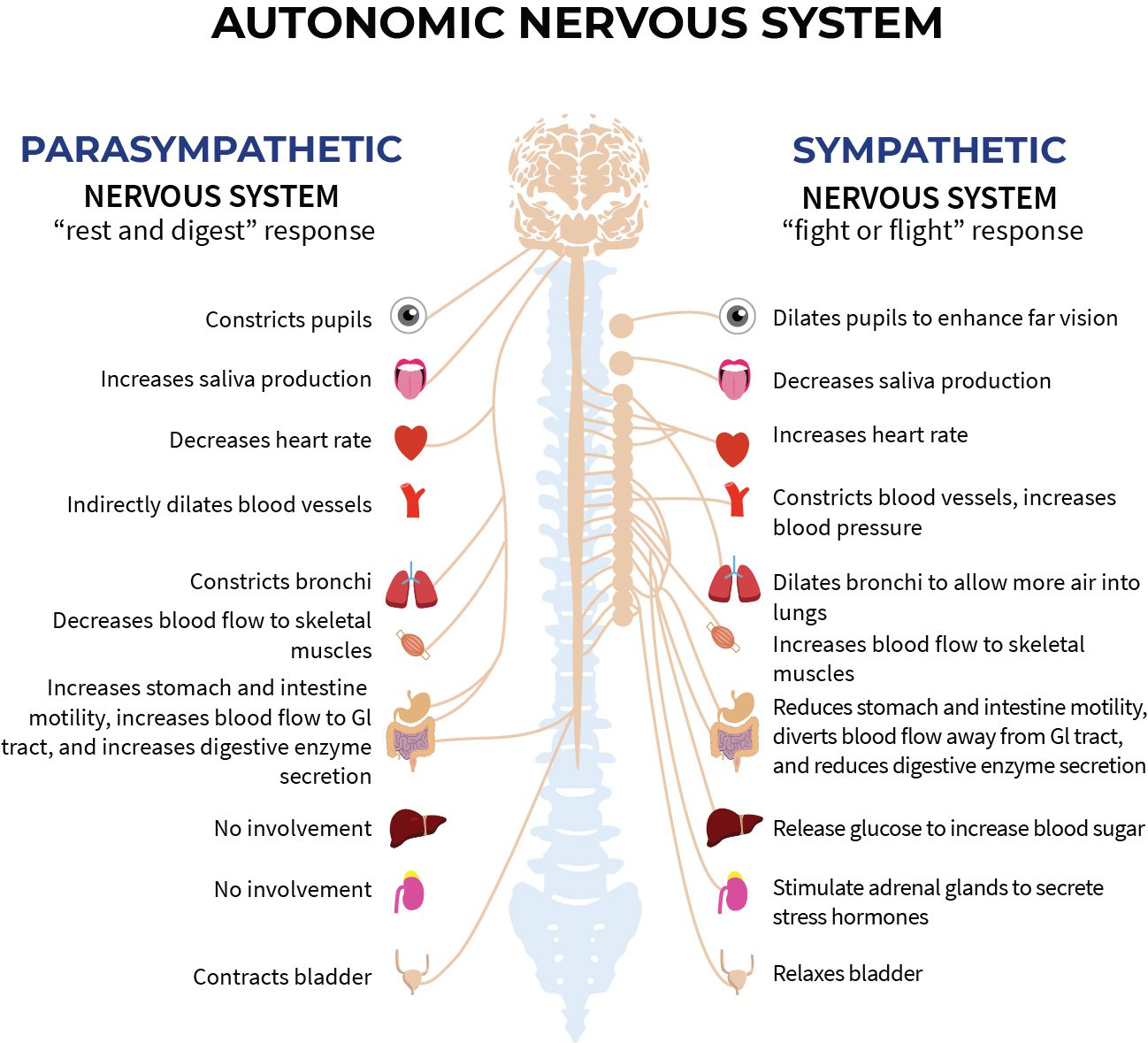

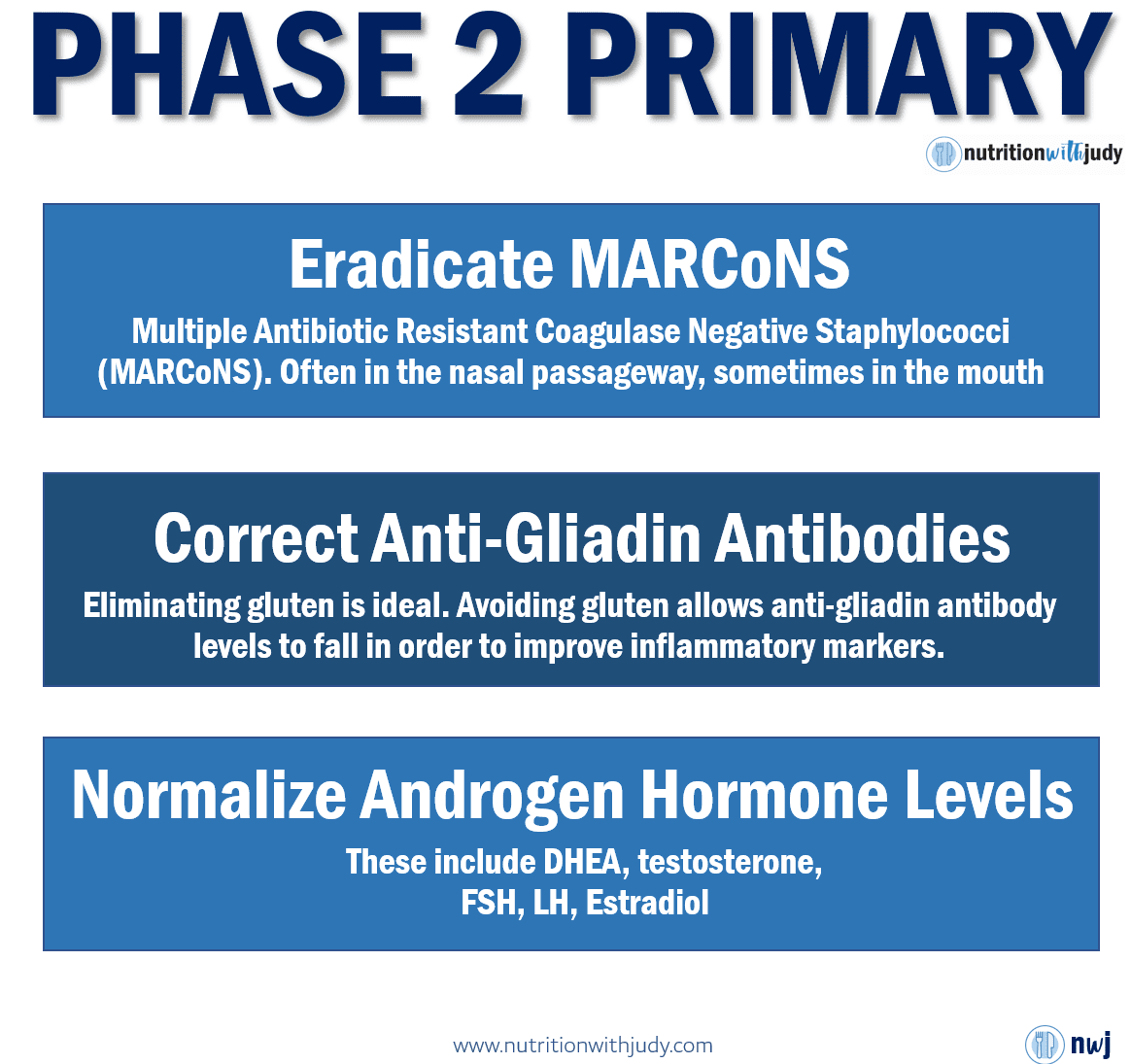

Eradicating Multiple Antibiotic Resistant Coagulase Negative Staphylococci, or MARCoNS, is needed before moving on to the next phase. MARCoNS promotes inflammation, immune dysfunction, and low MSH. EDTA, colloidal silver, and Mucolox nasal sprays can be used for MARCoNS treatment. These bacteria reside in the nose but can form deeper infections in dental cavitations, though this is rare.
This step can be achieved by eliminating gluten from the diet. Avoiding gluten allows anti-gliadin antibody levels to fall in order to improve inflammatory markers. Since low MSH and low VIP are both hallmark blood markers of CIRS, many patients experience gastrointestinal (GI) issues. Biotoxin elimination can also help achieve better gut health. SIBO is also common in CIRS patients. Practitioners may decide to implement SIBO treatment and other gut healing protocols to help patients better utilize the supplements and medications used in the following phases of the protocol.
Due to the biotoxin pathway, hormone levels are often impacted and require normalization at this step. This is patient-dependent based on their current blood markers. CIRS practitioners offer both over-the-counter supplementations in addition to prescription medications to help correct this.
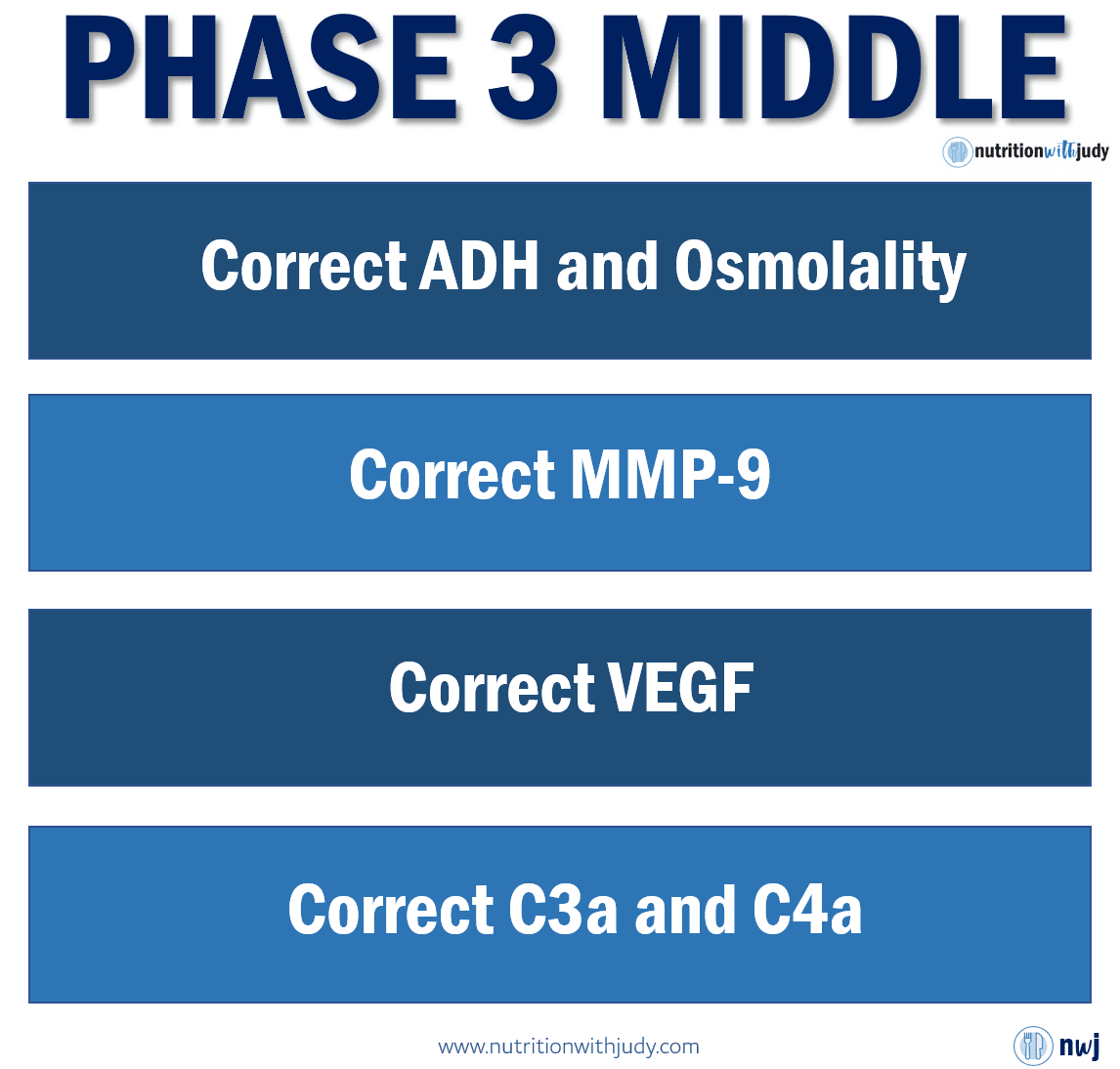

Dysregulated ADH and osmolality levels are common downstream effects from stage 7 of the biotoxin pathway. Low ADH can lead to dehydration, frequent urination, frequent thirst, static shocks, and headaches. DDAVP prescription medication is used to restore the body’s ability to hold onto water.
Elevated MMP-9 levels can cause leaky blood vessels, enabling inflammatory chemicals to enter various bodily tissue. A low-amylose diet, such as the carnivore diet, should also be implemented at this step in order to further assist with reducing MMP-9 levels and improve symptoms such as muscle aches, joint pain, and stiffness. High-dose fish oils also assist with this – if lipid therapy replacement isn’t utilized in phase 1, it must be implemented here to assist with the normalization of MMP-9.
Low VEGF also requires correcting in order to help improve blood flow and oxygen delivery throughout the body. High-dose fish oils are the support for normalizing VEGF levels in CIRS patients.
Elevated C3a is often correlated with Lyme disease. If C3a continues to be elevated at this point of the protocol, practitioners can utilize certain antibiotic treatments as well as high-dose statin drugs temporarily. If statin drugs are needed, CoQ10 offers side-effect support for patients.
As patients respond to the earlier steps in the protocol, C4a levels generally begin to correct on their own. If a patient experiences an increase after normalization, this is usually an indicator of re-exposure. For CIRS patients that are confirmed out of exposure and successfully completed the other steps, VIP will correct C4a levels at the end of the protocol.
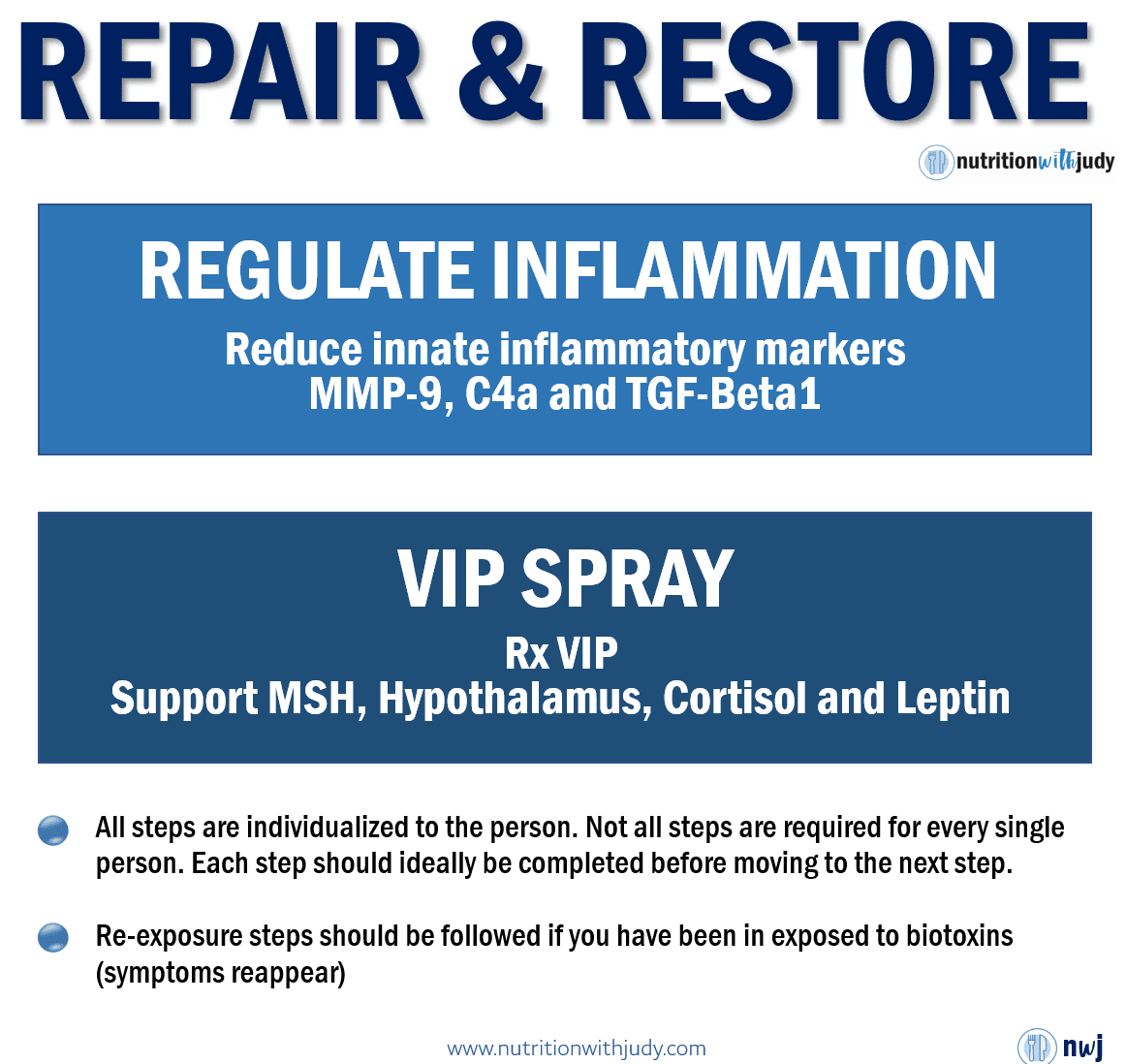

Elevated TGF Beta-1 can cause a host of issues including dysfunctional changes and autoimmunity. As inflammation is mitigated with prior steps, TGF Beta-1 often corrects on its own. At step 10, if this blood marker remains elevated, it can be treated with losartan prescription medication. Blood pressure monitoring will be conducted to ensure the safety of CIRS patients.
VIP nasal spray is the last step in the CIRS Shoemaker Protocol and has the ability to correct any residual symptoms the patient is experiencing. It also can help promote the restoration of innate immune system regulation. Practitioners will ensure that patients meet the specific criteria required for taking VIP while monitoring lipase levels.
Once all 11 steps of the Shoemaker Protocol are completed, the patient should be free of symptoms and cured of CIRS. All dysregulated blood markers will be corrected and downstream effects of biotoxin exposure addressed.
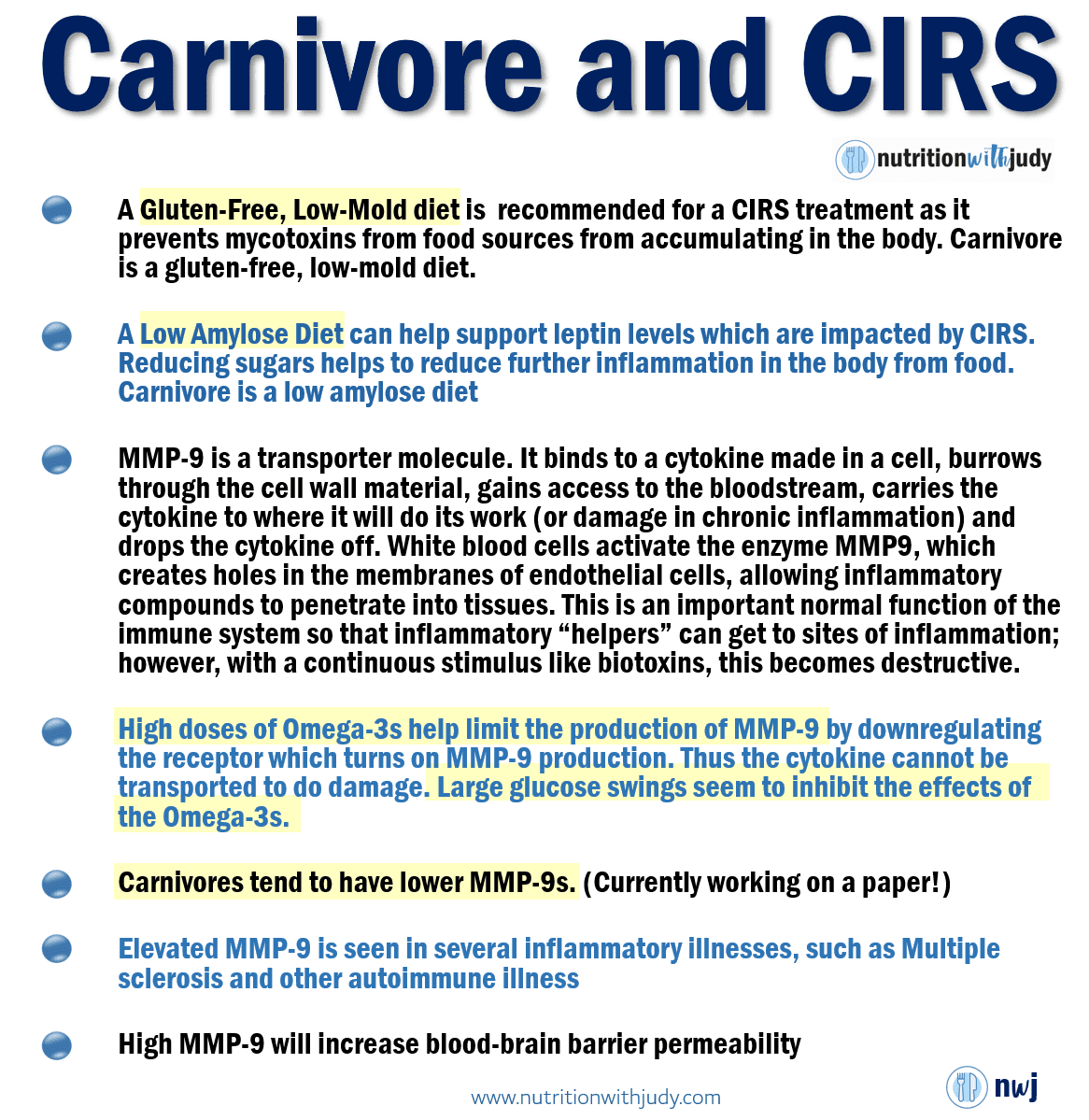

A gluten-free diet is recommended for CIRS treatment as it’s designed to help support the gut and reduce any imbalanced gliadin (gluten) antibody markers. A gluten-free diet can also help to reduce mycotoxin exposure (but remember, this is not the cause of CIRS). A low-amylose diet helps to reduce the MMP-9 levels with less inflammation from sugars. A carnivore diet supports both a gluten-free and low-amylose diet, which we recommend for CIRS treatment. Since CIRS is characterized as a multi-system, multi-symptom condition caused by whole-body inflammation, the carnivore diet offers the most anti-inflammatory option while also assisting with gut healing so that you can better tolerate the protocol. In our clinical experience, CIRS patients utilizing a carnivore diet generally have better blood markers when starting the protocol.
On the flip side– if you’ve been on the carnivore diet for six months or more and aren’t able to fully heal or are still experiencing symptoms, we highly recommend exploring CIRS. There seem to be significantly higher rates of CIRS diagnoses in the carnivore community as many of us are looking for alternative root-cause healing.
Stay tuned as we are actively advocating for the carnivore diet to be recommended as a part of the CIRS treatment protocol.
Mast cells are essentially our immune watchdogs to help protect the body from invaders. When a threat is found, chemical mediators are released that stimulate reactions to occur. There are over 200 of these reactions, and one of these chemical mediators is a histamine response.
A histamine release isn’t always related to mast-cell activation. Histamine is often elevated with CIRS and it is due to histamines being part of the innate immune system (the side that sees CIRS but can’t flag the adaptive immune system to rid the toxins).
Oftentimes, you will see that when the C4a goes up, the histamine switch will turn on and histamines will be more prevalent. In this case, histamines are turned on by gene activation and not specifically due to mast cell activation. Most patients don’t care what turned on the histamines, they just want to feel fewer histamine reactions such as facial flushing, itching, and diarrhea.
Histamine intolerance, sometimes referred to as mast cell activation, is very common in CIRS patients. Biotoxins, particularly mold mycotoxins, exposure is one of the root causes of histamine intolerance. Further exacerbated by low MSH levels that cause “leaky junctions”, those experiencing high histamine sensitivity often require additional support through diet intervention (low histamine diet or carnivore diet with unaged meat) and the histamine toolbox of temporary prescription medications and supplements available from CIRS providers. The good news is that histamine intolerance often resolves once the treatment protocol has been successfully completed.
CIRS can often be confused as a mold allergy but it’s important to discern that CIRS is not a mold allergy. CIRS and mold allergies are two separate and distinct immune issues. It is possible but rare for a person to have both– they simply will have a greater challenge. Histamine regulation generally becomes a higher level priority in this case. This may require involving an allergist for additional mold allergy support and may require testing in order to determine the cause of histamine disturbances. Work with your CIRS provider if this is the case.
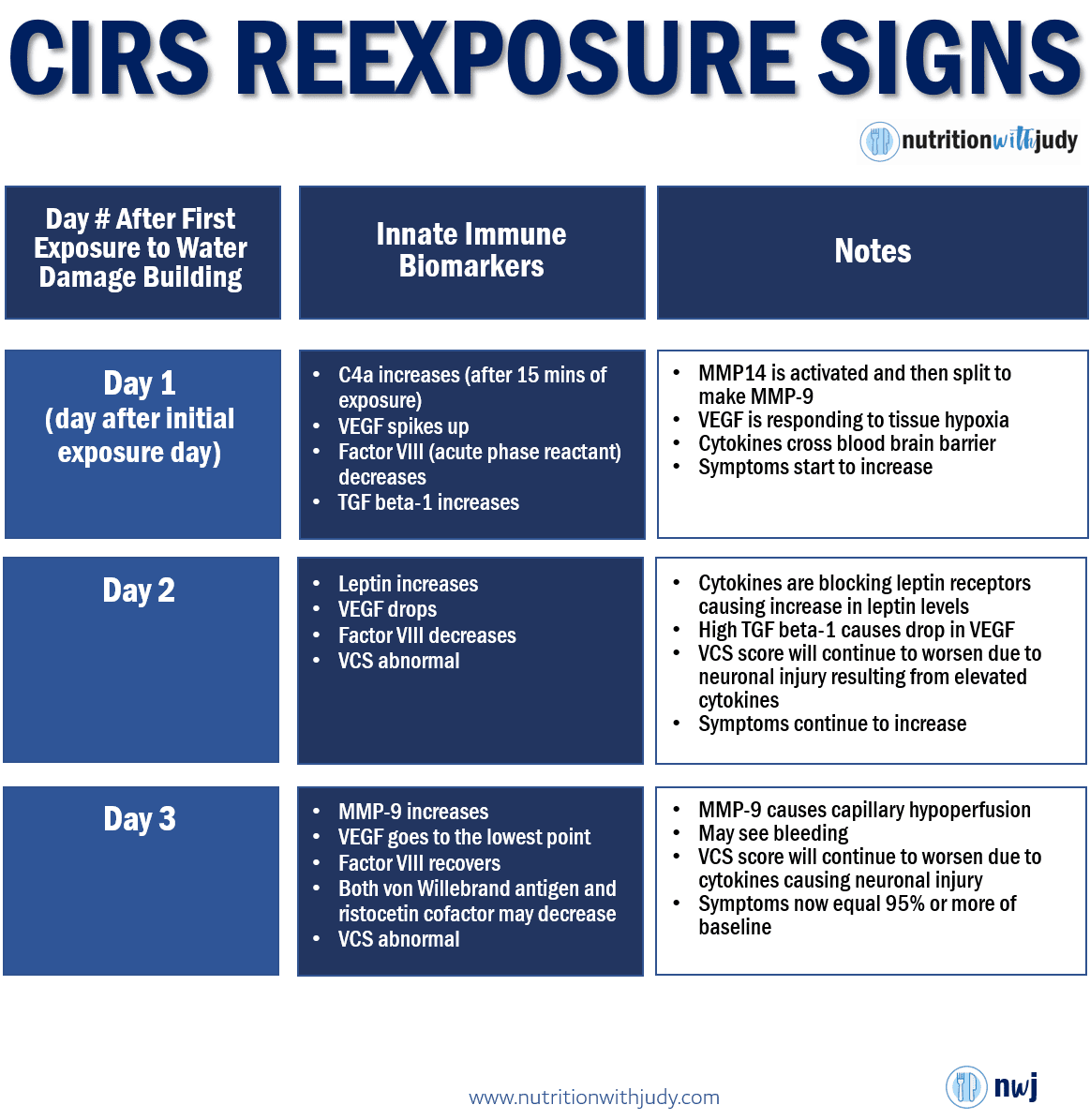

While the treatment protocol can seem daunting to anyone, there is so much hope knowing that CIRS is completely curable and reversible when following the clinically-backed Shoemaker protocol. For many who have suffered from long-term chronic illness, a CIRS diagnosis offers the once-in-a-lifetime opportunity for root cause healing.
The great news is that once you complete the protocol, you’ll never get that sick again. Future exposures can be managed with a couple weeks of taking CSM or Welchol, giving CIRS patients the opportunity to live a full life. Patients should continue working with their trusted CIRS provider to manage subsequent exposures and maintain their optimal health.
The Nutrition with Judy team offers CIRS bloodwork and CIRS White Glove Service in order to help guide you through the initial start of the protocol and provide a confirmed diagnosis. This comprehensive service includes all the testing requirements for CIRS diagnosis, environmental biotoxin determination, recommended dietary and supplement protocols, MARCoNS nasal testing, lipid replacement therapy, along with individualized resources and contacts to get you successfully started on your CIRS healing journey. With personalized doctor recommendations, we’ll help you find the right CIRS practitioner that can prescribe the necessary medication and provide comprehensive care for completing the Shoemaker protocol. Our team offers specialized gut healing, second opinions, and mind-body work to help set you up for success during your healing journey. As a CIRS proficiency partner with significant experience supporting CIRS patients, the Nutrition with Judy team is happy to provide any additional support you need.
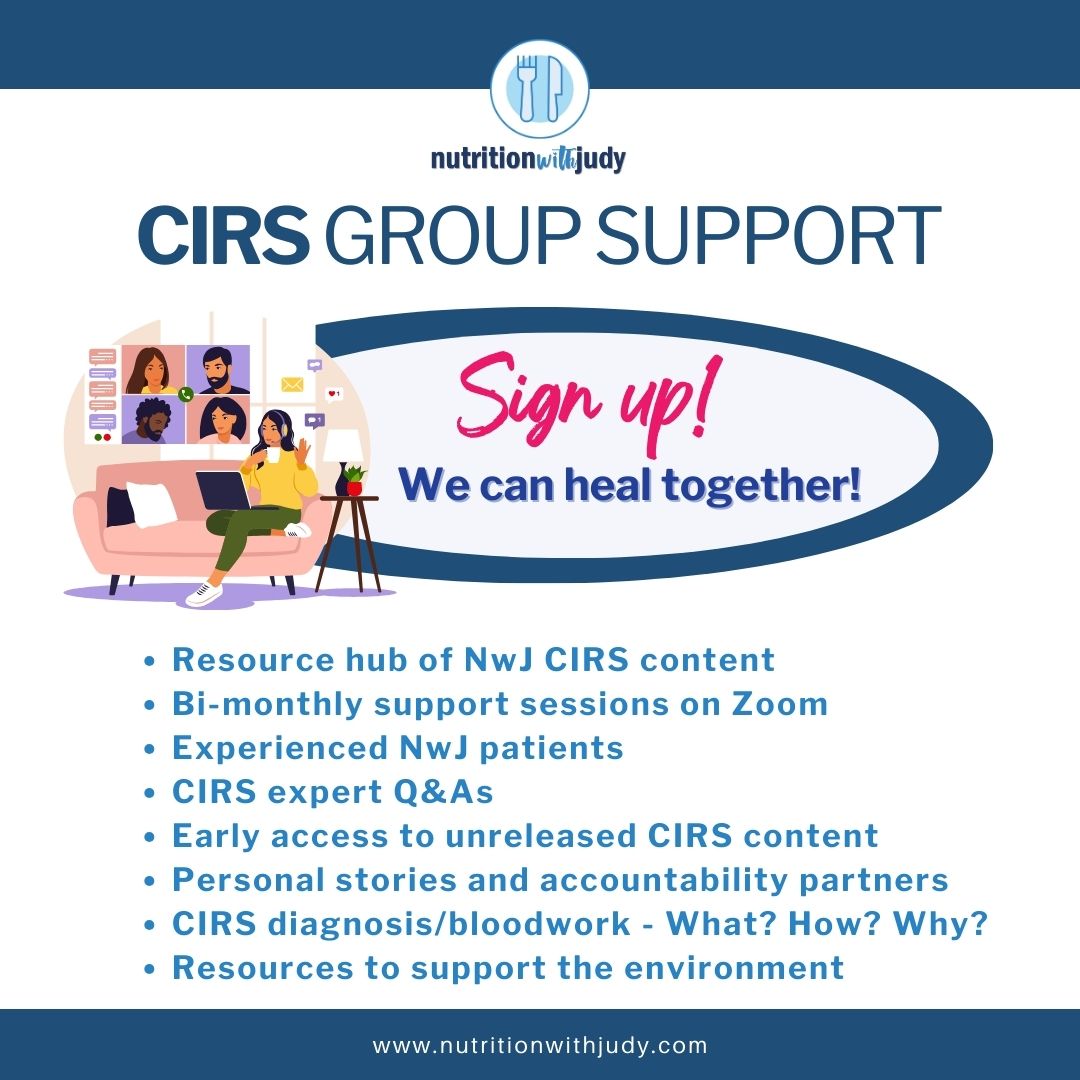

For individuals seeking comprehensive practitioner-led and community support on their CIRS journey, we welcome you to join our exclusive NwJ CIRS Group Support. Join today for access to extensive resources, a like-minded community, and unparalleled care as we journey to root-cause healing together.
Start your CIRS root cause healing journey today and contact us any time with any questions or concerns.
DISCLAIMER: This content is for educational purposes only. While we are board-certified in holistic nutrition and nutritional therapy practitioners, we are not providing medical advice. Whenever you start a new diet or protocol, always consult with your trusted practitioner first.